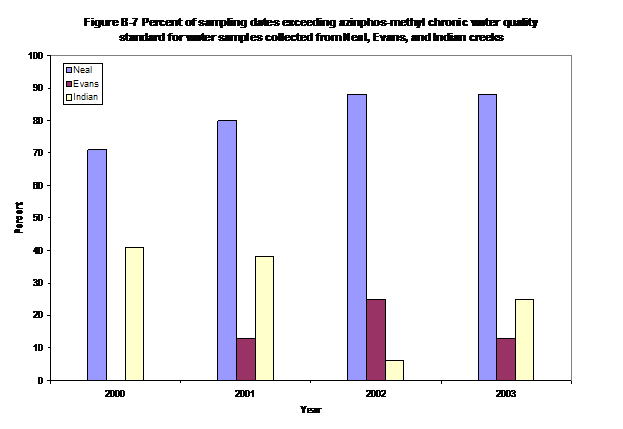HRGSA
BMP Project / Areawide II Handbook
Pesticide
Monitoring in Hood River Area Streams
![]()
![]()
Since the Oregon
Department of Environmental Quality (DEQ) began sampling in 1999, there has
been an ongoing monitoring program for pesticides in
Water samples were
collected during two different periods of each growing season from several
locations in the
As part of an ongoing
monitoring program, reported here are the chlorpyrifos and azinphos-methyl
monitoring results for the years 2000 to 2003. Results to date are presented to
show overall progress towards reducing the occurrence of these commonly used OP
pesticides in
Monitoring for OPs
and other pesticides in water at low parts per trillion levels (1 ppt = 0.001
micrograms per liter or ug/l) is analytically challenging. In addition, the use
of rapid and cost effective methods for sampling and analysis often requires
that analytical instrumentation be pushed to its limits. However, the ability
to detect pesticides at such low levels is necessary in order to assess stream
loading relative to the Clean Water Act (CWA) criteria for the protection of
aquatic life. The CWA standards for chlorpyrifos are 0.042 micrograms per liter
for chronic exposure and 0.081 micrograms per liter for acute exposure.
Currently, azinphos-methyl has only a chronic water quality standard of 0.010
micrograms per liter.
Different strategies
were employed by DEQ and OSU to address the analysis challenge. DEQ used
multi-residue methods to analyze for total residues (bound to sediment and
dissolved), while OSU used single residue methods to analyze for dissolved
residues only. DEQ reports values above the method detection limit; generally
0.02 micrograms per liter, whereas OSU reports values above the instrument
detection limit of 0.001 micrograms per liter. In addition, OSU sampled Neal,
Evans, and Indian creeks, collecting triplicate samples three times weekly at
about mid-day, whereas DEQ sampled Neal, Evans, and Lenz creeks, collecting
single samples less frequently. These
In addition, in
successive years sampling plans have been modified slightly. For example,
between 2001 and 2002 the sampling site on Indian Creek was moved downstream
approximately 0.5 mile, and the
azinphos-methyl sampling period was extended from the end of June to
mid-July.
Differences in
sampling times, analysis methods, and detection limits must be considered when
attempting to make comparisons between years and between DEQ and OSU monitoring
results. However, based on sampling and analysis methods described above,
several general observations can be made:
s
DEQ and OSU data from common streams showed similar trends for
samples with detectable concentrations of chlorpyrifos and azinphos-methyl, and
samples exceeding water quality standards, although maximum concentrations
reported by DEQ were generally higher.
s
Concentrations which exceeded the acute water quality standard
(WQS) for chlorpyrifos were not frequent and generally decreased from 2000 to
2003, except at Lenz Creek.
s
Although more frequent, concentrations which exceeded the chronic
WQS for chlorpyrifos generally decreased from 2000 to 2003. OSU results show
that concentrations exceeding the chronic WQS were transient; often for only
one sampling date, and no more than two successive sampling dates.
s
Concentrations which exceeded the chronic WQS for azinphos-methyl
were relatively common and have become more frequent at some sample collection
locations.
s
Both grab samples and continuous sampling periods show no
relationship between rainfall patterns and OP concentrations in water.
Results of the OSU
monitoring program from 2000 to 2003 (beginning with the azinphos-methyl use
period in 2000) are shown in Figures B-1 to B-7. ![]()

![]()

![]()





Both DEQ and OSU
sampling found very few detections of phosmet. As phosmet has a short half-life
in solutions at pH greater than 6.5, rapid degradation in
Although the results
for chlopyrifos and phosmet are encouraging, those for azinphos-methyl are
cause for concern. Regulatory action may result if voluntary efforts to correct
the situation are not successful.
Lack of a discernable
relationship between rainfall and OP concentrations in water is suggestive that
runoff may not be a significant factor in stream loading. Further research is
necessary to investigate this preliminary finding.
Assuming responsible
mixing/loading and storage practices, drift associated with pesticide
application practices continues to be implicated as the primary contributor to
stream loading. A major focus of future research should be improvement of drift
mitigation measures which prevent the direct input of spray drift into streams
and minimize deposition in riparian areas surrounding these aquatic
resources.
For more information on the OSU study Contact
Jeffrey Jenkins, Department of Environmental and Molecular Toxicology,